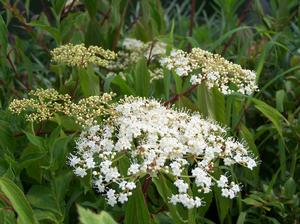View All Plants :: View All DECIDUOUS SHRUBS
Viburnum betulifolium
Birchleaf Viburnum
Plant Type:
DECIDUOUS SHRUBSViburnum betulifolium – This is a large, seldom encountered Viburnum with birch-like leaves, henceforth, the common name Birchleaf Viburnum. New growth is bronze-red maturing dark green. Showy, fragrant flat-topped white flowers adorn in May/June. Late season clusters of round red glossy berries follow showy white flat-topped white flowers in May/June. Fruits develop much of the summer on long pedicels that stretch and become lax while maintaining an open, rounded form that reminds us of an exploding firework. From green to dull, light yellow to pink-orange the clusters of fruits in late season metamorphose to glossy red. Unlike many Viburnum, V. betulifolium is self-pollinating, not requiring another to make fruit. Red fall foliage color with hot pink highlights some years mixed with yellow and orange is striking in autumn. Curiously, foliage often points ground-ward as the season progresses much in the manner of Cornus kousa. We are increasingly impressed with our plants as they grow larger. Birchleaf Viburnum is a very low maintenance shrub requiring fertile, moisture-retentive soil in part shade to full sun. Viburnum betulifolium tolerates heavy clay soils. This ought to be of interest to arboretums. Avoid constantly wet ground or spots that trend to arid dust between rains.
Characteristics and Attributes for Viburnum betulifolium
Season of Interest (Flowering)
- Spring
Season of Interest (Foliage)
- Spring / Summer / Autumn
Autumn Interest
- Fruit / Berries / Seed Heads
- Autumn Leaf Color
Nature Attraction
- Songbirds
- Deer Resistant
- Honey Bees & Native Bees
Light
- Full Sun
- Mostly Sunny
Attributes
- Specimen
- Shrub Border
- Wildlife Garden
- Hedge
- Hedgerow
Growth Rate in the Garden
- Moderately Fast
Soil
- Fertile
Origins
- China
Propagated By
- Cutting Grown
Genus Overview: Viburnum
Common Name: Viburnum
Viburnum. This genus is full of fantastic, multi-season garden worthy shrubs. Garden heroes. Spring flowers, often large and showy, many with heady sweet fragrance are arranged in cymes. Some smell of musk (Viburnum dilatatum) while others produce no fragrance at all. Flowers are followed with berries. If late season and autumn berries are desired then planting two of a species will ensure fruit set; for instance, Viburnum dilatatum 'Erie' and V. dilatatum 'Michael Dodge' will pollinate each other and produce fruit. Viburnum cassinoides is closely allied with V. nudum; but if the flowering times do not overlap then there will be no fruit. However, if you plant V. nudum 'Winterthur' in proximity with V. nudum var. angustifolium, 'Longwood', 'Moonshine' or 'Pink Beauty' berries will abound. Another interesting example is V. lantana which crosses with V. burejaeticum and vice versa. Any V. plicatum f. tomentosum selection such as 'Shasta' or 'Shoshoni' will pollinate with all other V. plicatum f. tomentosum selections like 'Copper Ridges or 'Pink Beauty'. But if you were to plant two 'Shasta' side by side with no other V. plicatum f. tomentosum in near proximity then your effort will be fruitless. As with almost all in the universe of plants there are exceptions. There is one viburnum which appears to be self-fruitful, Viburnum setigerum the Tea Viburnum. Another interesting exception to the rule is Viburnum nudum 'Pink Beauty' which is also self-fruitful - a departure from its siblings. And on the other spectrum are two I can think of off-hand that are barren, Viburnum plicatum 'Roseum' and Viburnum plicatum 'Kern's Pink'. Oftentimes, the dwarf viburnums reamin in a juvenile state and do not produce fruit. All Viburnum of any size that do produce fruit are magnificent in the late season garden. And they feed all manner of birds. Larger, denser shrubs provide cover and nesting opportunities. Nearly all Viburnum have terrific autumn foliage colors, too. Viburnums are members of Caprifoliaceae. All prefer part to full sun and fertile soils. All are cutting grown. Many thanks to Gary Ladman of Classic Viburnums who generously set us straight regarding some of the details we had originally incorrectly lauded... ya can't know everything!


